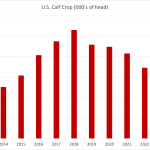Wheat prices have shot to new Canadian records and analysts say the
Canadian Wheat Board should be able to capture these prices through the
winter.
On Sept. 26, the new CWB Pool Return Outlook bumped up milling wheat
values by $39-$49 per tonne from the August PRO. It also pushed up
durum by $26-$32 and raised feed wheat and low quality durum by $10.
Feed barley rose by $6 per tonne.
Since the August PRO, malt barley prices have jumped by $22 for six-row
Read Also

Canola used in only quarter of Canadian biofuel
Less than one-quarter of the biodiesel and renewable diesel used in Canada in 2024 was made from canola oil feedstock
varieties and by $18 for two-row varieties, but most of that increase
was revealed in a special mid-September PRO.
These increases mean that No. 1 Canada Western Red Spring wheat with
12.5 percent protein is forecast to return at port $8.27 per bushel,
No. 1 Canada Western Amber Durum with 12.5 percent protein will bring
$8.06, No. 1 Canada Western Feed Barley should bring $4.07, Special
Select Canada Western Two Row malting barley should return $5.20 and
Special Select Canada Western Six Row malting barley should earn $4.86.
CWB market analyst David Boyes said world grain markets are beginning
to stabilize at these high price levels and, when combined with
contracted sales, allowed the board to predict these returns for grains.
“I hope some guys out there have some supplies because this is
definitely the year when you want to have something to sell,” said
Boyes.
Alberta Agriculture grain market analyst Charlie Pearson said there is
little threat to world grain prices in the short term because there are
no large crops coming to market.
But he said the present high wheat prices will inspire winter wheat
growers in the United States to plant 10-20 percent more acres this
fall. If that crop develops well, the rally in wheat will probably end
next May or June, when the winter wheat crop begins to be harvested.
“Timing of sales this year will be crucial,” said Pearson. Presently
there is an inverse in U.S. wheat futures markets, showing that the
market is betting the high prices won’t be maintained once the next
U.S. crop comes in.
“I think it’s important that the wheat board, as much as possible,
stack their sales through the wintertime and leave the spring alone.”
But by avoiding the possibility of a price decline in the spring,
farmers will also lose out on the chance of a continuing rally that
would occur if the winter wheat crop gets into trouble, Pearson said.
“If there are problems next spring, hold on to your hat,” he said.
Boyes said the sudden run-up in wheat and durum prices that has
occurred is not just a market bubble but a reflection of the true size
of world grain stocks.
“The tightness of high quality wheat and durum has been confirmed,” he
said.
“The market is adjusting to the fact that it is not just speculative
any more. We know there’s less wheat. We know there’s a lot less
quality wheat.”
The Australian wheat crop, which often spoils winter prices if it is in
good condition, is so bad that it may produce only half its usual
volume. The Australian drought is also cramping world durum supplies,
kicking prices higher.
The CWB also released its final PRO for the 2001-2002 crop year,
showing small gains for wheat, larger gains for durum, static feed
barley prices and a slight drop for malting barley.
Boyes said the huge price rally that has recently occurred happened
after most of the 2001-02 crop was sold, but the slightly higher prices
in wheat reveal the rally’s beginning.
“They probably captured a bit of the price rally that occurred at the
end of May,” said Boyes.

















